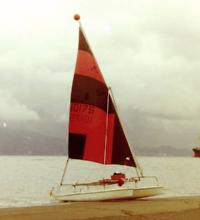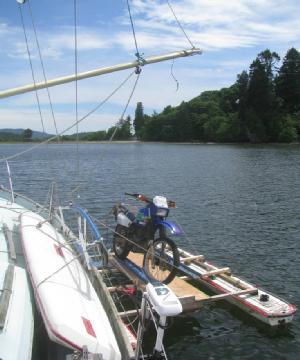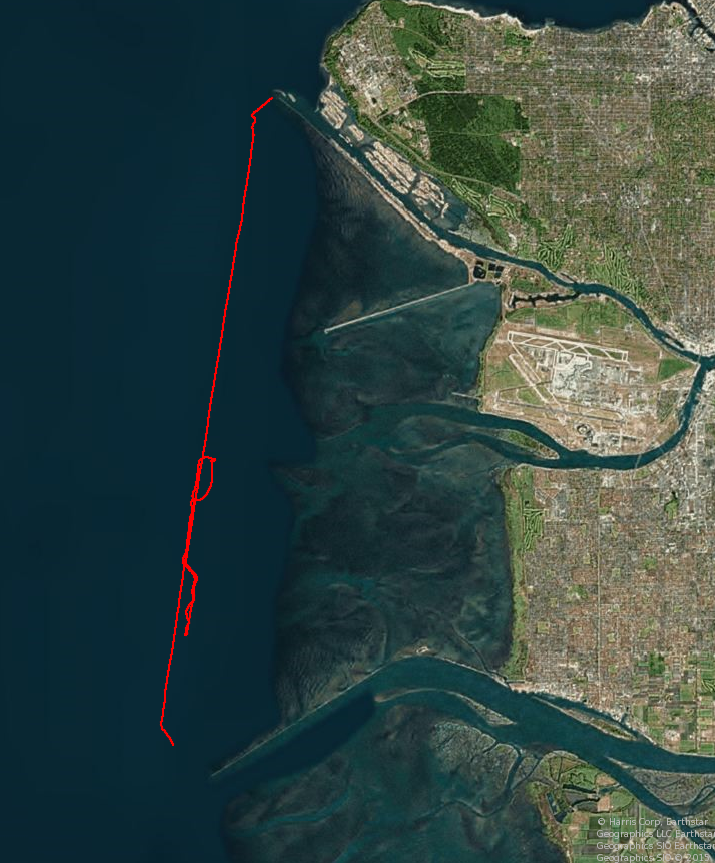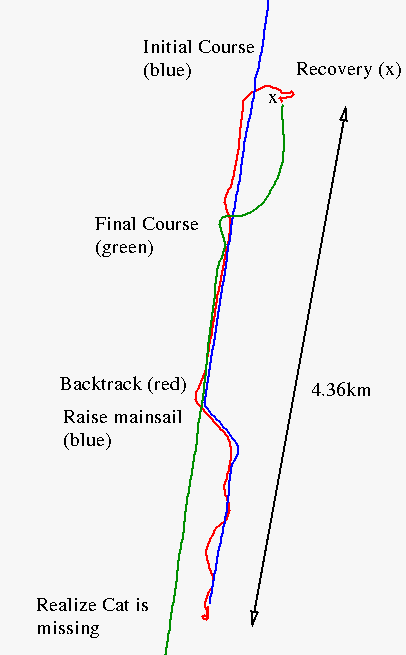


Following my acquisition of Alastor, the cat sat in our garden collecting a patina of dirt and lichen for many years, with the trampoline bed being occasionally used as a literal trampoline until the stitching rotted and the fabric broke. Later, someone stole the tubular aluminium frame, presumably for the metal.
In 2008, I started bringing my motorcycle on board Alastor, which greatly extended my travel options ashore. But getting the bike ashore required a dock, and many places I visit don't have one. Putting the bike on Alastor's "official" tender, an Avon Redcrest, would be totally impractical and would probably lead to the bike sinking to the bottom, even though I've done that with a bicycle. Then I thought of the cat. Worth trying, without spending any real money anyway.
First I had to rescue it from under a fallen tree, then patch up and re-seal
the hulls. Then, since the frame was missing, I used some old lengths of
2x3 wood to make a simple frame, and added an old piece of 2x8ft plywood.
Then the critical experiment - it did indeed take the weight of the bike,
and myself as long as I didn't stand right at one stern. I had an
electric trolling motor I'd bought to use with the Avon, and made a mounting
block to take that - it worked much better on the cat than on the inflatable.


Initially I used the spinnaker pole and a block to lower the bike onto the
cat, but later cut some of the original aqua-cat mast to make a derrick.
It's still not completely satisfactory.

Later, the original 2x3 wood along the hull broke, so I replaced it with
new 2x4, and also painted the hulls yellow to somewhat mask the age
discolouration.
The hulls still leak - somewhere - but with drain plugs on each stern
it is not too onerous to empty a few litres of water every couple of days. The
hulls still have some built-in buoyancy, in the form of a few foam
blocks and sealed milk containers, so worst case the hulls should not
sink to the bottom if totally flooded.


This was about 9pm - somewhat after sunset, and quite dark. But it
was fairly calm - not much wind, and little swell - so I determined
to turn back and look for it. There was a stretch of about 13km
to search, which seemed hopeless, but nothing ventured, nothing gained.
Vancouver airport is located on Sea Island, just to the east, and is well
lit. So sailing north, looking west to port it was dark and hard to see anything,
but looking east to starboard it was a bit lighter, the lights of the airport
and city some 8km away reflected off the water.
I reasoned that it should be easiest to see something to starboard,
so using the GPS I steered a reverse course which was supposed to be
a couple of hundred metres west of my southward course. It didn't
quite work out like that , but that was the idea.

There was a some wind from the south-east, and halfway down I had raised sail with a short dog-leg into the wind. In theory, that might have pushed the cat to the north-west, but I thought it more likely to drift with the current. This was shortly after high tide; the tidal atlas for Georgia Strait showed the tidal stream as "confused" - not very helpful, but at least not very strong. The GPS shows course-over-ground, of course - not ideal, but better than nothing.
After back-tracking about 4km, searching with binoculars, I spotted a dark shape in the water almost like a log about 300m to starboard. I turned toward it and lost sight, but found it again after a few moments. Sure enough, it was the catamaran, so after catching the bridle with a boathook I made it fast to a cleat, making sure this time to drop the loop of the bridle over a post as well.


I've done this kind of thing before - I found a motorcycle wheel nut searching a 3km stretch of road - but there was a fair bit of luck involved. In retrospect, I should have sailed a return track further west to account for the uncertainty in drift - or perhaps, sailed the one I did northward and then a more westerly one southward again. I should also have put some reflective material and for that matter proper identifying marks on the cat, like "T/T Alastor" - as I hadn't spent much real money on it, only time, I hadn't bothered with making sure it could be found.
Probably everyone knew but me that you shouldn't cleat polypropylene - I'll have to be more careful with that, too.
Andrew Daviel, 2015